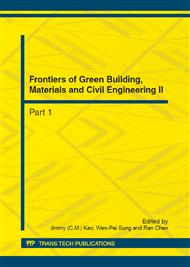p.411
p.418
p.423
p.427
p.431
p.435
p.440
p.444
p.448
Strength and Resistance of Alkali-Activated Slag Concrete to High Temperature
Abstract:
This study presents an investigation into high-temperature resistance of alkali-activated slag concrete (AASC). Sodium oxide (Na2O) concentrations of 4%, 5% and 6% of slag weight and liquid sodium silicate (SiO2) with modulus ratio of 0.8 ( mass ratio of SiO2 to Na2O ) were used as activators to activate granulated blast furnace slag (GBFS). All cylindrical specimens with the same binder content and liquid/binder ratio of 0.5 were cast and cured in the air, under the saturated limewater and in a curing room at relative humidity of 80% RH and temperature of 60 °C, respectively. Test results demonstrate that the high-temperature resistance of AASC decreased with an increase of temperature. The compressive strength and high-temperature resistance of AASC improved with an increase dosage of Na2O and AASC cured at relative humidity of 80% RH and temperature of 60 °C has the superior performance, followed the AASC by air curing and saturated limewater curing. The higher compressive strength and superior high-temperature resistance have been obtained in AASC than comparable OPC.
Info:
Periodical:
Pages:
431-434
Citation:
Online since:
August 2012
Authors:
Keywords:
Price:
Сopyright:
© 2012 Trans Tech Publications Ltd. All Rights Reserved
Share:
Citation:


